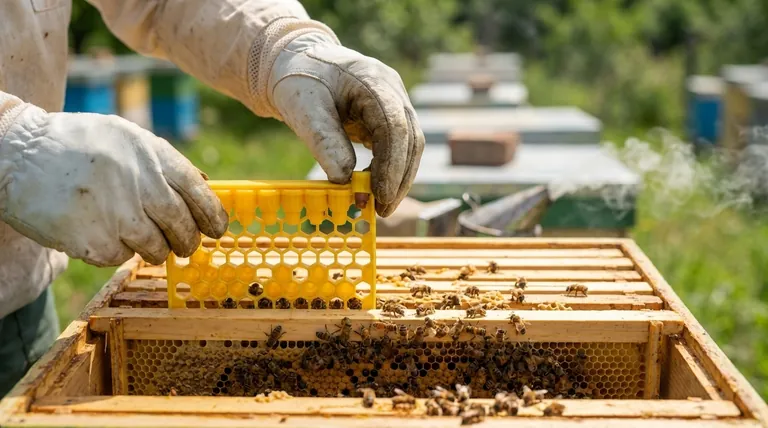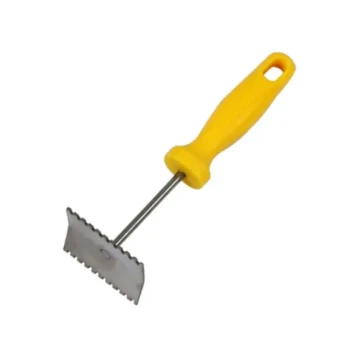At its core, the fate of a fertilized honeybee egg is not determined by its genetics but by its environment. The crucial difference between a worker and a queen comes down entirely to the diet the larva is fed by the nurse bees in the colony.
The decision to create a queen or a worker is a form of developmental plasticity controlled by the colony. By manipulating a larva's diet, nurse bees can direct its development, effectively choosing to activate or suppress its reproductive potential based on the hive's needs.

The Role of Diet in Caste Determination
A fertilized egg holds the potential for royalty. Whether that potential is realized depends on the nutritional path it takes in the first few days of its life as a larva.
The Common Starting Point
All fertilized eggs are diploid, meaning they have a full set of chromosomes from both the queen and a drone. Genetically, any one of these eggs can become either a worker or a queen.
The Critical Dietary Switch
For the first two to three days, all female larvae are fed a protein-rich secretion from the glands of young nurse bees. This substance is known as royal jelly.
The Queen's Exclusive Diet
A larva chosen to become a queen is fed royal jelly exclusively and in large quantities throughout its entire larval development. This special diet triggers a cascade of hormonal and physiological changes, leading to the full development of her ovaries and larger body size.
The Worker's Standard Diet
After the first few days, larvae destined to become workers are switched to a different diet. They are fed a mixture of pollen and honey often called "bee bread." This less-rich diet suppresses their reproductive development, ensuring they become sterile female workers.
Architectural Cues for Nurse Bees
The structure of the honeycomb itself provides the signals that guide the nurse bees' feeding behavior. The colony doesn't leave this critical decision to chance.
Standard Worker Cells
Most larvae are raised in the familiar, horizontally-oriented hexagonal cells that make up the bulk of the comb. A larva in one of these standard cells will receive the standard worker diet.
The Specialized Queen Cell
When a colony needs a new queen, workers construct special cells. These queen cells are much larger, shaped like a peanut shell, and typically hang vertically from the comb.
How the Cell Signals the Diet
The unique size, shape, and orientation of a queen cell act as a clear physical cue. When nurse bees encounter a larva inside one of these specialized cells, they instinctively know to provide the continuous, high-volume diet of royal jelly required to raise a queen.
Understanding the Developmental Outcome
The two distinct diets lead to two radically different types of bees, each optimized for a specific function within the colony's superorganism.
The Path of a Queen
The royal jelly diet allows for rapid growth and full sexual maturation. The resulting queen is significantly larger than a worker, develops functional ovaries capable of laying thousands of eggs per day, and lives for several years. Her sole purpose is reproduction.
The Path of a Worker
The bee bread diet results in a smaller bee whose reproductive organs remain undeveloped. Instead, her body develops glands for producing wax and royal jelly, barbed stingers for defense, and pollen baskets on her legs for foraging. She is a sterile female optimized for labor, living only a few weeks during the busy season.
How the Colony Decides Its Future
The colony's decision to raise a new queen is a collective one, driven by specific circumstances and needs.
- If the colony needs to swarm: The bees will proactively build several queen cells to raise new queens, one of which will take over the hive after the old queen leaves with a portion of the colony.
- If the existing queen is failing or suddenly lost: Workers will perform "emergency queen rearing" by selecting a few existing cells with very young female larvae, modifying the cells to become queen cells, and immediately switching the larvae's diet to pure royal jelly.
By controlling nutrition, the honeybee colony demonstrates a remarkable ability to engineer its own leadership and ensure its long-term survival.
Summary Table:
| Caste | Larval Diet | Cell Type | Key Outcome |
|---|---|---|---|
| Queen | Exclusive Royal Jelly | Large, vertical 'queen cell' | Fully developed reproductive system, long-lived |
| Worker | Royal Jelly, then Bee Bread/Pollen | Standard horizontal comb cell | Sterile, specialized for hive labor (wax, foraging, defense) |
Empower Your Apiary with HONESTBEE
Understanding the intricate biology of your hive is key to successful beekeeping. Just as the right diet determines a bee's future, having the right equipment is crucial for your operation's health and productivity.
HONESTBEE supplies commercial apiaries and beekeeping equipment distributors with the high-quality, durable supplies needed to support thriving colonies. From hive components to harvesting tools, our wholesale-focused operations ensure you get the reliable gear your business depends on.
Ready to equip your operation for success? Contact HONESTBEE today to discuss your wholesale supply needs.
Visual Guide

Related Products
- Jenter Queen Rearing Kit Complete Set for Bee Breeding
- No Grafting Queen Rearing Kit: System for Royal Jelly Production and Queen Rearing
- Nicot Queen Rearing Kit for Beekeeping and Grafting in Nicot System
- Brown Nicot Queen Cell Cups for Breeding Queen Bees Beekeeping
- Retractable Chinese Queen Rearing Grafting Tools Equipment
People Also Ask
- What happens to the colony population during the 5–6 weeks after a new queen emerges? Understand the Natural Dip and Rebound
- What are the implications of delayed oviposition in queen bees? A Strategy for Superior Queen Quality
- What are the stages involved in queen raising? A Guide to Controlled, High-Quality Queen Production
- How long does it take for a new queen to emerge, mate, and lay eggs? A Beekeeper's 10-14 Day Guide
- What genetic pathways differ in QE-queens? Unlocking the Master Controls of Queen Bee Biology



















